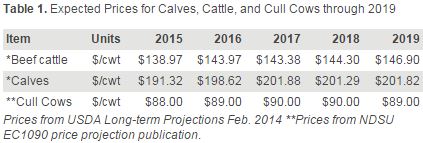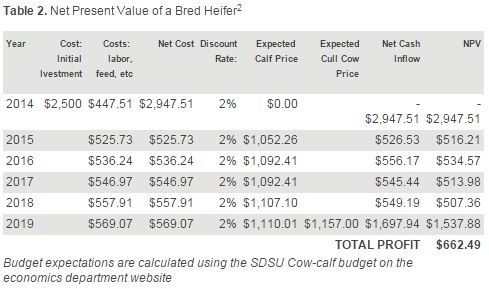



How Much Could You Afford For a Bred Heifer?
Calculations around herd expansion need projections and the importance of forecasting prices cannot be overlooked, write US cattle advisers.When it comes to the price of bred cattle, how high is too high? In the last few years cow-calf producers have seen an increase in returns, write South Dakota State University extension agents Shannon Sand and Warren Rusche.

They add, however, that expansion has been slow due to droughts, high feed costs, storms, and high prices of replacement heifers. With the drop in feed prices and the expected high returns on cattle in the next few years many producers have been wondering if it is time to expand their herd?
In order for a producer to know if it is the right time for them to expand it is important to look at the lifetime of the heifer and the number of calves she will produce over her lifetime. To do this a set of price projections are necessary for both the value of the calf and the value of the cow when ready to cull (Table 1).
Table 1 shows projected prices for beef cattle, calves, and cull cows through 2019. These projected prices are lower than what is currently observed in the marketplace.
The importance of looking at these long run projections when deciding whether or not to expand cannot be overlooked. Using more conservative values helps prevent bull market fever from affecting decisions. Table 1 shows that in 2017 beef cattle prices are expected to decline slightly compared to 2016 and then increase again in 2018. Knowing these prices a producer can better plan their future herd expansions.
It is also important a producer look at their budget and know what it costs for them to get a calf to market. If it is cost prohibitive to buy a bred heifer then the producer may need to raise additional replacements rather than sending them to market or look at alternatives, such as buying an older bred cow. If a producer can afford to have additional bred heifers added to the operation then it is important to look at the potential revenue stream the heifer could generate in today’s dollars.
To look at the potential profit of a bred heifer and all of her potential offspring a Net Present Value (NPV) Model can be used. An NPV model adjusts for the time value of money. NPV is defined as the difference between the present value of cash inflows and outflows. NPV can be used in capital budgeting to analyze the profitability of investing in a bred heifer1 (Table 2).
Table 2 shows the Net Present Value of a bred heifer purchased in 2014. Table 2 assumes the heifer has her first calf in 2015 and her last calf in 2019 and is sold as a cull cow in 2019. The calves are expected to weigh 550 lbs. when they go to market and when culled the cow is expected to weigh 1300 lbs.
According to Table 2 the expected total profit for the heifer and all of her offspring will be $662.49 over the lifetime of the animal. This table would change based on how many calves the heifer actually produces. It is important when looking at expanding the herd that producers take a long term view.
This is especially true given the current market prices of buying a bred (heifer) or replacement. Although every situation is different and an operations’ individual costs and production history should be used to make decisions, based on the assumptions in this NPV model there appears to be potential for buying bred heifers and making a profit over the animal’s lifetime.
References:- Sand, Shannon, 2014. Buying Late Bred Cows and Their Potential for Additional Revenue.
- USDA, 2014. USDA long-term Projections February 2014.
- Haugen, Ron, and Tim Petry, Frayne Olson, and Dwight Aakre. 2014. Plotting a Course. NDSU Extension Publication. EC1090.
- Hughes, Harlan. 2010. What is a Pregnant Heifer Worth in Today’s Market? Beef Magazine.




